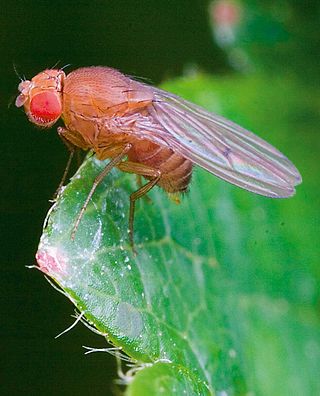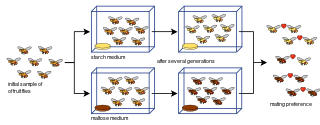Related Research Articles

Drosophila is a genus of flies, belonging to the family Drosophilidae, whose members are often called "small fruit flies" or pomace flies, vinegar flies, or wine flies, a reference to the characteristic of many species to linger around overripe or rotting fruit. They should not be confused with the Tephritidae, a related family, which are also called fruit flies ; tephritids feed primarily on unripe or ripe fruit, with many species being regarded as destructive agricultural pests, especially the Mediterranean fruit fly.

Drosophila melanogaster is a species of fly in the family Drosophilidae. The species is often referred to as the fruit fly or lesser fruit fly, or less commonly the "vinegar fly", "pomace fly", or "banana fly". Starting with Charles W. Woodworth's 1901 proposal of the use of this species as a model organism, D. melanogaster continues to be widely used for biological research in genetics, physiology, microbial pathogenesis, and life history evolution. As of 2017, six Nobel Prizes have been awarded to drosophilists for their work using the insect.

The Drosophilidae are a diverse, cosmopolitan family of flies, which includes species called fruit flies, although they are more accurately referred to as vinegar or pomace flies. Another distantly related family of flies, Tephritidae, are true fruit flies because they are frugivorous, and include apple maggot flies and many pests. The best known species of the Drosophilidae is Drosophila melanogaster, within the genus Drosophila, also called the "fruit fly." Drosophila melanogaster is used extensively for studies concerning genetics, development, physiology, ecology and behaviour. Many fundamental biological mechanisms were discovered first in D. melanogaster. The fruit fly is mostly composed of post-mitotic cells, has a very short lifespan, and shows gradual aging. As in other species, temperature influences the life history of the animal. Several genes have been identified that can be manipulated to extend the lifespan of these insects. Additionally, Drosophila subobscura, also within the genus Drosophila, has been reputed as a model organism for evolutionary-biological studies, along with D. sechellia for the evolution of host specialization on the toxic noni fruit and Scaptomyza flava for the evolution of herbivory and specialist on toxic mustard leaves.

Obaid Siddiqi FRS was an Indian National Research Professor and the Founder-Director of the Tata Institute of Fundamental Research (TIFR) National Center for Biological Sciences. He made seminal contributions to the field of behavioural neurogenetics using the genetics and neurobiology of Drosophila.

Michael Ashburner was an English biologist and Professor in the Department of Genetics at University of Cambridge. He was also the former joint-head and co-founder of the European Bioinformatics Institute (EBI) of the European Molecular Biology Laboratory (EMBL) and a Fellow of Churchill College, Cambridge.

Octopamine (molecular formula C8H11NO2; also known as OA, and also norsynephrine, para-octopamine and others) is an organic chemical closely related to norepinephrine, and synthesized biologically by a homologous pathway. Octopamine is often considered the major "fight-or-flight" neurohormone of invertebrates. Its name is derived from the fact that it was first identified in the salivary glands of the octopus.

Drosophila simulans is a species of fly closely related to D. melanogaster, belonging to the same melanogaster species subgroup. Its closest relatives are D. mauritiana and D. sechellia.
The Drosophila melanogaster species subgroup contains 9 species of flies, including the best known species Drosophila melanogaster and D. simulans. The subgroup belongs to the Drosophila melanogaster species group within the subgenus Sophophora.
FlyBase is an online bioinformatics database and the primary repository of genetic and molecular data for the insect family Drosophilidae. For the most extensively studied species and model organism, Drosophila melanogaster, a wide range of data are presented in different formats.

white, abbreviated w, was the first sex-linked mutation discovered, found in the fruit fly Drosophila melanogaster. In 1910 Thomas Hunt Morgan and Lilian Vaughan Morgan collected a single male white-eyed mutant from a population of Drosophila melanogaster fruit flies, which usually have dark brick red compound eyes. Upon crossing this male with wild-type female flies, they found that the offspring did not conform to the expectations of Mendelian inheritance. The first generation produced 1,237 red-eyed offspring and three white-eyed male flies. The second generation produced 2,459 red-eyed females, 1,011 red-eyed males, and 782 white-eyed males. Further experimental crosses led them to the conclusion that this mutation was somehow physically connected to the "factor" that determined sex in Drosophila. This led to the discovery of sex linkage, in which the gene for a trait is found on a sex chromosome. Morgan named this trait white, now abbreviated w. Flies possessing the white allele are frequently used to introduce high school and college students to genetics.
Period (per) is a gene located on the X chromosome of Drosophila melanogaster. Oscillations in levels of both per transcript and its corresponding protein PER have a period of approximately 24 hours and together play a central role in the molecular mechanism of the Drosophila biological clock driving circadian rhythms in eclosion and locomotor activity. Mutations in the per gene can shorten (perS), lengthen (perL), and even abolish (per0) the period of the circadian rhythm.

In molecular biology, Small nucleolar RNA snoR639 is a non-coding RNA (ncRNA) molecule which functions in the biogenesis (modification) of other small nuclear RNAs (snRNAs). This type of modifying RNA is located in the nucleolus of the eukaryotic cell which is a major site of snRNA biogenesis. It is known as a small nucleolar RNA (snoRNA) and also often referred to as a 'guide RNA'.

Most animal testing involves invertebrates, especially Drosophila melanogaster, a fruit fly, and Caenorhabditis elegans, a nematode. These animals offer scientists many advantages over vertebrates, including their short life cycle, simple anatomy and the ease with which large numbers of individuals may be studied. Invertebrates are often cost-effective, as thousands of flies or nematodes can be housed in a single room.

3-Iodotyrosine is an intermediate in the synthesis of thyroid hormones which is derived from iodination of tyrosine at the meta-position of the benzene ring. One unit can combine with diiodotyrosine to form triiodothyronine, as occurs in the colloid of the thyroid follicle. Two units can combine to form 3,3'-diiodothyronine.

The halloween genes are a set of genes identified in Drosophila melanogaster that influence embryonic development. All of the genes code for cytochrome P450 enzymes in the ecdysteroidogenic pathway (biosynthesis of ecdysone from cholesterol). Ecdysteroids such as 20-hydroxyecdysone and ecdysone influence many of the morphological, physiological, biochemical changes that occur during molting in insects.
The microbiota are the sum of all symbiotic microorganisms living on or in an organism. The fruit fly Drosophila melanogaster is a model organism and known as one of the most investigated organisms worldwide. The microbiota in flies is less complex than that found in humans. It still has an influence on the fitness of the fly, and it affects different life-history characteristics such as lifespan, resistance against pathogens (immunity) and metabolic processes (digestion). Considering the comprehensive toolkit available for research in Drosophila, analysis of its microbiome could enhance our understanding of similar processes in other types of host-microbiota interactions, including those involving humans. Microbiota plays key roles in the intestinal immune and metabolic responses via their fermentation product, acetate.

Laboratory experiments of speciation have been conducted for all four modes of speciation: allopatric, peripatric, parapatric, and sympatric; and various other processes involving speciation: hybridization, reinforcement, founder effects, among others. Most of the experiments have been done on flies, in particular Drosophila fruit flies. However, more recent studies have tested yeasts, fungi, and even viruses.
Metavirus is a genus of viruses in the family Metaviridae. They are retrotransposons that invade a eukaryotic host genome and may only replicate once the virus has infected the host. These genetic elements exist to infect and replicate in their host genome and are derived from ancestral elements unrelated from their host. Metavirus may use several different hosts for transmission, and has been found to be transmissible through ovule and pollen of some plants.
Semotivirus is the only genus of viruses in the family Belpaoviridae. Species exist as retrotransposons in a eukaryotic host's genome. BEL/pao transposons are only found in animals.
Cytochrome P450, family 305, also known as CYP305, is an animal cytochrome P450 family found in insect genome. The first gene identified in this family is the CYP305A1 from the Drosophila melanogaster.
References
- ↑ Arain MS, Shakeel M, Elzaki ME, Farooq M, Hafeez M, Shahid MR, et al. (April 2018). "Association of detoxification enzymes with butene-fipronil in larvae and adults of Drosophila melanogaster". Environmental Science and Pollution Research International. 25 (10): 10006–10013. Bibcode:2018ESPR...2510006A. doi:10.1007/s11356-018-1202-4. PMID 29380196. S2CID 4780407.